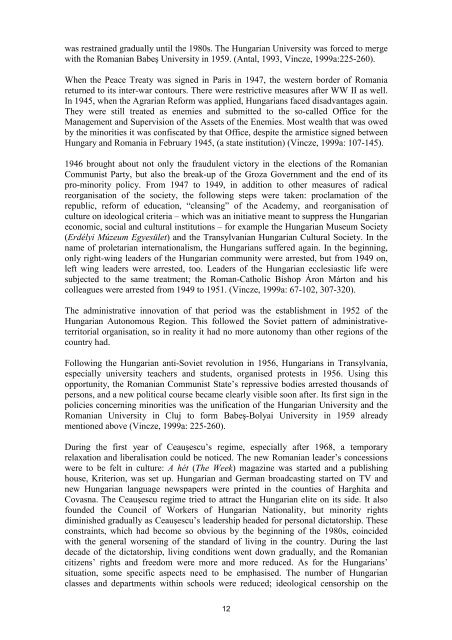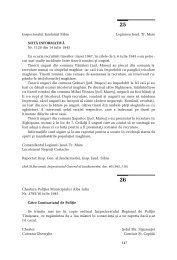Southeast Europe
Southeast Europe
Southeast Europe
You also want an ePaper? Increase the reach of your titles
YUMPU automatically turns print PDFs into web optimized ePapers that Google loves.
was restrained gradually until the 1980s. The Hungarian University was forced to merge<br />
with the Romanian Babeş University in 1959. (Antal, 1993, Vincze, 1999a:225-260).<br />
When the Peace Treaty was signed in Paris in 1947, the western border of Romania<br />
returned to its inter-war contours. There were restrictive measures after WW II as well.<br />
In 1945, when the Agrarian Reform was applied, Hungarians faced disadvantages again.<br />
They were still treated as enemies and submitted to the so-called Office for the<br />
Management and Supervision of the Assets of the Enemies. Most wealth that was owed<br />
by the minorities it was confiscated by that Office, despite the armistice signed between<br />
Hungary and Romania in February 1945, (a state institution) (Vincze, 1999a: 107-145).<br />
1946 brought about not only the fraudulent victory in the elections of the Romanian<br />
Communist Party, but also the break-up of the Groza Government and the end of its<br />
pro-minority policy. From 1947 to 1949, in addition to other measures of radical<br />
reorganisation of the society, the following steps were taken: proclamation of the<br />
republic, reform of education, “cleansing” of the Academy, and reorganisation of<br />
culture on ideological criteria – which was an initiative meant to suppress the Hungarian<br />
economic, social and cultural institutions – for example the Hungarian Museum Society<br />
(Erdélyi Múzeum Egyesület) and the Transylvanian Hungarian Cultural Society. In the<br />
name of proletarian internationalism, the Hungarians suffered again. In the beginning,<br />
only right-wing leaders of the Hungarian community were arrested, but from 1949 on,<br />
left wing leaders were arrested, too. Leaders of the Hungarian ecclesiastic life were<br />
subjected to the same treatment; the Roman-Catholic Bishop Áron Márton and his<br />
colleagues were arrested from 1949 to 1951. (Vincze, 1999a: 67-102, 307-320).<br />
The administrative innovation of that period was the establishment in 1952 of the<br />
Hungarian Autonomous Region. This followed the Soviet pattern of administrativeterritorial<br />
organisation, so in reality it had no more autonomy than other regions of the<br />
country had.<br />
Following the Hungarian anti-Soviet revolution in 1956, Hungarians in Transylvania,<br />
especially university teachers and students, organised protests in 1956. Using this<br />
opportunity, the Romanian Communist State’s repressive bodies arrested thousands of<br />
persons, and a new political course became clearly visible soon after. Its first sign in the<br />
policies concerning minorities was the unification of the Hungarian University and the<br />
Romanian University in Cluj to form Babeş-Bolyai University in 1959 already<br />
mentioned above (Vincze, 1999a: 225-260).<br />
During the first year of Ceauşescu’s regime, especially after 1968, a temporary<br />
relaxation and liberalisation could be noticed. The new Romanian leader’s concessions<br />
were to be felt in culture: A hét (The Week) magazine was started and a publishing<br />
house, Kriterion, was set up. Hungarian and German broadcasting started on TV and<br />
new Hungarian language newspapers were printed in the counties of Harghita and<br />
Covasna. The Ceauşescu regime tried to attract the Hungarian elite on its side. It also<br />
founded the Council of Workers of Hungarian Nationality, but minority rights<br />
diminished gradually as Ceauşescu’s leadership headed for personal dictatorship. These<br />
constraints, which had become so obvious by the beginning of the 1980s, coincided<br />
with the general worsening of the standard of living in the country. During the last<br />
decade of the dictatorship, living conditions went down gradually, and the Romanian<br />
citizens’ rights and freedom were more and more reduced. As for the Hungarians’<br />
situation, some specific aspects need to be emphasised. The number of Hungarian<br />
classes and departments within schools were reduced; ideological censorship on the<br />
12









